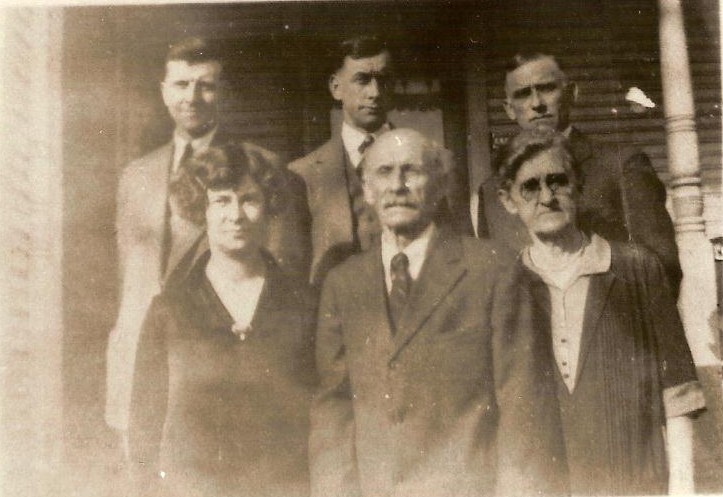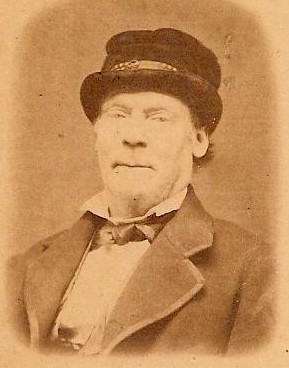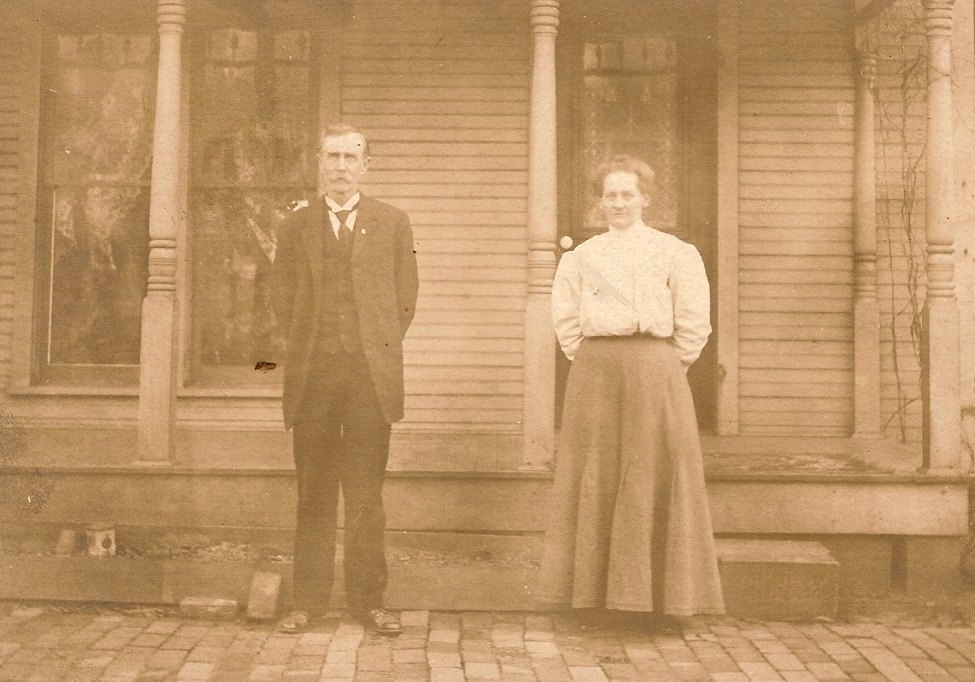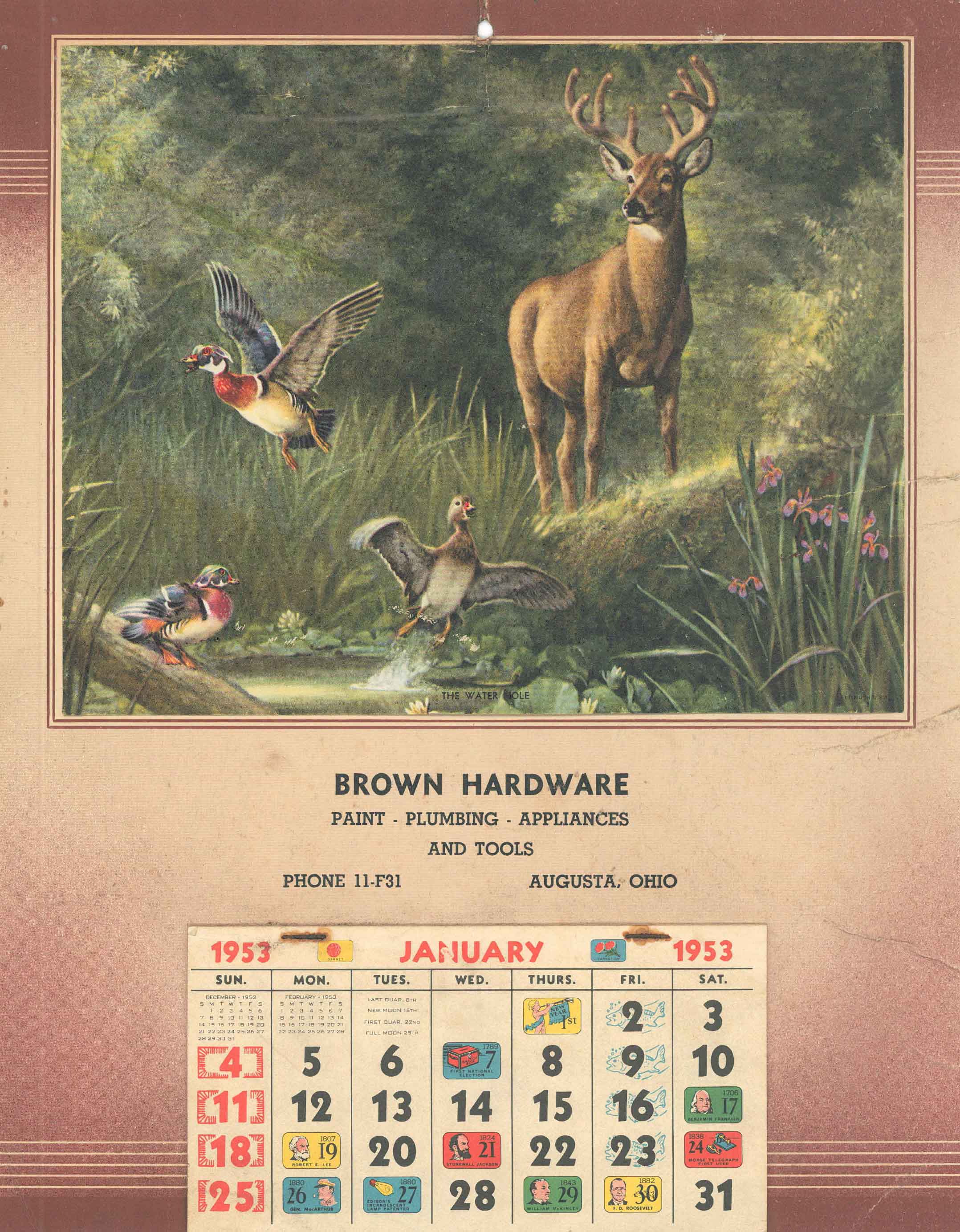by Taylor C. Woodward

AUGUSTA

Former historians say Jacob Brown
built a log hut where the
H. M. Shaw maple grove now stands, which
is 200 yards more or less south of the public square in Augusta, on
the east side of the road. This must have been the first house
in or near what is now Augusta, also Jacob Brown may have been here
as early as 1809. Augusta was first called Brownsville.
There must have been more than one family of Browns here in the
early history, as several different Brown's names appear on some of
the early deeds around Augusta.
Old deeds state on Sept. 7, 1812, Jacob Brown received from the
United States (James Madison, Pres.), by patent deed, the southeast
Quarter of Sec. 15, Twp. 15, R. 5. Also August 10, 1813, the
northwest Quarter of Sec. 23, Twp. 15, R. 5 was transferred from the
United States by patent deed to Jacob Brown. This Quarter Sec.
Mr. Brown sold Feb. 29, 1816 to Thomas Brown 156.56 acres for
$792.80.
The following is a copy of Jacob Brown's original plat of Augusta,
which was recorded in Columbiana County March 31, 1818, and was
transcribed from their records and recorded in Carroll County July
27, 1868, James Holder, Recorder.
Section 15, Township 15, Range 5, beginning at a post in the New
Philadelphia Road, where a white oak 16 inches in diameter is, N. 21
degrees 30 " W. 8 links. All the lots fronting on Main Street
are 60 feet in front and 160 feet deep, and those fronting on Market
Street are 60 feet in front and 180 feet deep. Main and Market
Streets are each 60 feet wide. Certified to be a true plat,
James Craig, surveyor - Feb. 28, 1818, Columbiana County, Ohio,
personally appeared before me one of the Justices of the Peace in
and for said county, Jacob Brown, and acknowledged the within Plat
of the town of Augusta and all the streets and alleys as his act and
deed agreeable to the laws providing for the laying out and
recording of town plats. Given under my hand March 3, 1818,
Joseph Springer, J. P. Recorded and compared, March 31, 1818, J.
Springer, Recorder.
In 1803,
Matthew Crawford, his son
William, and their families
emigrated from County Donegal, Ireland to the United States,
locating in Washington County, Penna. In 1820,
Matthew in
company with his three sons, came to what is now Augusta Township,
Carroll County, where his sons received 160 acres each of land by
deed, from the United States Land Office,
William
Crawford receiving
the southwest Quarter of Sec. 15, Twp. 15, R. 5. In 1836,
William
Crawford and
Nancy his wife, sold this quarter section to
their son
George for $650. It remaining in this name until the
1870's or later, the major part of it remains in the Crawford name
at the present time. A part of the west side of Augusta is
located in this quarter section.
The original lots of the village, when they were first sold, brought
from ten to twenty dollars each, many of them changing owners
several times in the early history, and each time at a higher price.
Jacob Brown and Rachel his wife sold lot No. 17 to
Samuel Wass 1821
for $10. They also sold lot 7 to James Rowley 1822 for $12,
lot 10 to Thomas McMillon 1825, lot 15 to
Stephen Manfull 1826 for
$10, lot 4 to Chris. Johnson 1832, lot 11 to Henry Johnson 1832,
part of lot 16 to Roger Morledge 1832. In 1824, Jacob Brown
sold 12 acres more or less adjoining Augusta on the south, to
Stephen Manfull for $90. In 1827, Jacob Brown sold the
remaining part of the southeast quarter Sec. 15 in Twp. 15, to
William Wrigglesworth for $1000.
|
|||||||||||||||||||||||||||||||||
The first business house said to have been in the village was a general store, keeping in stock almost everything needed by the pioneers of that day; this was conducted by a Mr. Morledge. A general store was also started by A. Hayes about the same time. James Gaston and William Higby were merchants of an early period. Manfull brothers operated a general store in the late 1820's and early 30's. George Manfull opened a second store about 1834, on the northwest corner of the square, this being on Lot No. 8 which was sold by James Rowley in 1837 to Thomas Kinsey, and he selling to John Manfull in 1854. This lot was sold by Chris. Manfull and Jonathan Milbourn as executors of John Manfull (dec.) to Frances Culp in 1864. This was where T. B. Culp's mammoth dry goods Emporium was located. T. B. Culp did a large business in the dry goods line all through the 1870's and was called the boss advertiser by the editor, as he usually had a two column ad in the Chronicle. In the 1870's and 80's, Augusta was called the Hub by several of the Carrollton people. It is said that George Manfull sold his store to Levi Marshall, and he to Stephen Wilson; this must have been their first store.
Charles H. Hayes was the first Justice of the Peace in Augusta Township. Jacob Simpson and Joseph Fleming were also early Justices of the Peace.
Manfull's 1st Addition: Sec. 15, Twp. 15, R. 5. Plat of Jehu Manfull's addition to the town of Augusta, taken April 4, 1877 by E. D. Shaw, a stone at the southeast corner of Lot No. 50. I hereby certify that the above is a correct survey of Manfull's first addition to the town of Augusta. E. D. Shaw, C. S. Recorded June 26, 1877, W. M. Hagerman, Recorder, Carroll County, Ohio.
George Gans came to Augusta in 1869 and formed a partnership the same year with T. J. Crawford and Albert Heston, and opened a general store at the present location of the J. W. Brice garage. It was known as the Crawford, Heston and Gans store. In 1873, Crawford and Gans bought out Heston. Then it was Crawford and Gans. After a period of time, Venemon A. Manfull joined the partnership, then they operated under the name of Crawford, Gans & Manfull.
In 1879, Crawford, Gans and Manfull purchased the entire stock of dry goods owned by T. B. Culp, leased the large store room and moved into their new location. In 1884, Crawford, Gans and Manfull bought all of T. B. Culp's property. Mr. Culp went to Minerva where he conducted a general store for a short period of time, then moved to Alliance where he operated the T. B. Culp's dry goods store for several years. In Sept. 1886, the junior member of the firm, Mr. Manfull, passed away very suddenly, he having worked that day helping to move heavy boxes. After this the partnership was Crawford and Gans.
In 1889, they were in possession of a dry goods store, a men's clothing store, and a hardware. After a peaceful twenty year partnership, they mutually agreed to divide. Crawford taking the dry goods store and building, Gans taking the men's clothing store, the hardware and buildings.
|
|
About the year 1903, Edgar Crawford was elected State Senator from this district, and served his tenure of office in the Ohio State Senate. From this time on, William Crawford conducted the store the most of the time until he passed away in 1944, after which his widow, Mrs. Ina Crawford conducted the store until it was sold to Ralph McCartney, who operated it for a few years, until he was struck by a train at a crossing, from which he died. The store then was sold to Denton Locke, who was the last owner to conduct a store in this building.
George Gans was proprietor of a men's clothing store in the 1880's and the early 1890's, in a store room adjoining the Crawford and Gans general store. This building is now owned by the Masons. This clothing store was conducted for several years by H. B. "Ben" Manfull. J. M. Long conducted a clothing store in Augusta for six years, and probably at this location. In the year 1900, a door was made between these two store rooms. Prior to this, the clothing store was a separate store: after this the clothing store was operated in conjunction with Crawford's Store.
A small weekly newspaper called The Augusta Gazette was published in Augusta in 1879, for a period of time by William Roach, Adam Myers and others.
In 1873, the Masons and the Odd Fellows each erected new two story brick buildings on Main Street in Augusta, the Masons on the west half and the Odd Fellows on the east half of lot No. 17, each using the second floor rooms for their meetings and leasing the first floor for store rooms.
In the early 1880's, we find a hardware store in one building, conducted by Len. Cunningham and a general store in the other building, conducted by Ashbrook and Turnipseed. Ashbrook must have sold out to Turnipseed, as Len. Cunningham bought the entire stock of merchandise of D. B. Turnipseed, in the spring of 1885; Mr. Turnipseed moving to Kensington, where he took over another store. After taking over both stores, Mr. Cunningham put in a new line of dry goods, millinery, hats, etc., procuring the services of Miss Nellie Curtis, said to be one of the best milliners in Cleveland, to have charge of the millinery department.
quite
often would have a one or two column ad in the county paper, held
discount sales, gave chances on prizes, paid cash for farm produce,
or trade for groceries, dry goods, or hardware.
In late 1886 or early 1887,
Len. Cunningham sold out to his brother.
Richard Cunningham took over both stores, carrying on the same line
of goods with more, added a line of jewelry, men's ready made, also
tailor made suits were added. J. Clark Etling, a cutter and
tailor was employed.
Mr. Cunningham also did a lot of
advertising, having a two column ad in the paper at times, paid cash
or traded for farm produce, and bought an immense lot of poultry in
the fall, and had a large trade in 1887.
About 2 A.M., Sunday, Feb. 12, 1888, fire was discovered in the ware
room in the back of the Odd Fellows block, and in a short time fire
was also discovered in the ware room in the rear of the Mason block
on the same lot, and just across a driveway from the first.
Before the citizens could be aroused, it was under such headway,
that all that could be done was to save adjoining buildings.
Every building on these lots together with the contents were
entirely consumed by fire.
Tom Cunningham's house on the next
lot east, though saved from burning, was entirely wrecked by falling
walls.
Richard Cunningham occupied the business rooms in both
buildings, also the large ware rooms. This was the largest
fire that had been in Augusta up to this time. It was presumed
$30,000 would cover loss, partly covered by insurance.
(Incendiary)
Lemuel Stockman, formerly from East Township, came to Augusta in the
early 1880's and started or took over a grocery store on the north
side of East Main Street. A news item of Jan. 1885 states
Frank Fleming, our barber has moved his shop to
Lem. Stockman's,
where he is going to teach
Lem. the art of barbering. From
this time on for many years,
Mr. Stockman operated a barber shop in
conjunction with the grocery store, assisted by his wife or daughter
in the store. This was in the days when a hair cut and shave
were a quarter; the quarter being worth twenty five cents in that
day. The writer of this has had many a fifteen cent hair cut
by
Lem.
Mr. Stockman continued to operate the barber shop and
store as long as his health would permit.
After
Mr. Stockman's death, his daughter and husband Charles Thomas,
conducted the store for a period of time until it was sold to
George Leatherberry, Lew.
Myers taking over the barber shop for
Mr. Leatherberry. After a short period of time,
Charles Leatherberry having learned the profession of barbering, and started
up in the Rutledge building, joined his father and took over the
barber shop. Later on,
Charles took over the entire store,
adding other lines of goods, meats, confectionery items, etc. and
remodeled the store, conducting this store with the assistance of
different members of the family, for the rest of his life.
Since his decease, a hardware store has been conducted by
Seth Owen,
in this building for a period of time.
In 1889,
D. H. and
J. W. Rutledge purchased the lot on which the Odd
Fellows building had been located (which was destroyed by fire the
year before), and erected a large two story frame building, in which
they opened up a general store in the first floor store room, the
second floor room being used as a town hall for many years as public
needs required. This store was conducted under the name of
Rutledge Bros.
In 1896, Rutledge Bros. removed their stock of clothing and dry goods to Bergholz, Ohio, and sold or leased their store to A. H. Myers and M. S. Milbourn. Mr. and Mrs. Myers conducted the store, assisted by their son Everett, Samuel Crawford, and probably others. Miss Lulu Long was in charge of the millinery department.
In Sept. 1898, A. H. Myers and M. S. Milbourn sold their store to Rutledge Bros.
Jan. 1899 Rutledge Bros. are closing out their store.
Mr. Douglas H. Hunter opened a hardware store in the Rutledge building in 1905, Mr. Brannan having moved to Kensington, where he took over a hardware.
In 1908, J. W. Rutledge and D. V. Manfull formed a partnership and opened a general store in the building which is now the J. W. Brice Garage. After a period of time, they moved the store to the Rutledge building, Mr. Hunter having sold his stock of hardware and moved to another location. Some time later Mr. Manfull sold out to Rutledge, who continued to operate the store for several years, with the help of others at times. Mr. and Mrs. Frank Manfull conducted the store for Mr. Rutledge for a period of time. Mr. Rutledge also was a funeral director, having learned the profession prior to this time, which profession he followed, conducting funerals as needs required. After many years in Augusta in the store business, the J. W. Rutledge family moved to Minerva, where they established the Rutledge Funeral Home.
The following have had general, grocery, and/or confectionery stores in this building at different times for a period of time: Charles Leatherberry, George Leatherberry, John Davis, Mr. Gherhelm, William Ferguson, Joseph B. George, Mr. and Mrs. Ed. McKee, Lee R. Finley, and Nick Lavkulich (Nick's), the present store.
|
|
In 1889, when Crawford and Gans dissolved partnership, George Gans was owner of a hardware store in the present J. W. Brice garage. In 1893, he sold the store to Frank Brannan and William Kennedy. Some time around 1895, Brannan and Kennedy sold out to John Thomas and sons Charles and Clarence of East Rochester.
While located in this building, a fire was discovered, a crowd soon gathered and a bucket brigade was formed, which soon brought the fire under control. The crowd all went home, but were soon called back, as the fire had broken out again, having eaten its way into the partitions, which made it a stubborn fire to bring under control, but it was finally extinguished; this time they remained with it. It started up the third time, but was soon extinguished. After a period of time, Thomas and sons moved the store to the McLean building, operating the hardware a few years in this building, when they sold out to Simeon Ashbrook, who continued to operate the hardware store until 1904, when the building and contents burned.
Carl Walters operated a garage and machine shop, on the north side of West Main Street. J. W. Brice garage, welding, and machine shop at above location, at present time. Frank Geffert, filling station operator, Saline Oil Co. Harley Brown conducted a hardware store in later years, on the south side of East Main Street, assisted by his father, Harry Brown.






